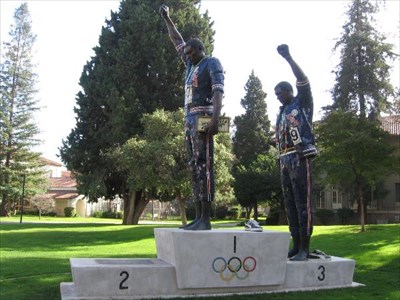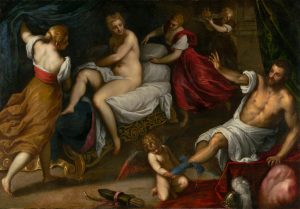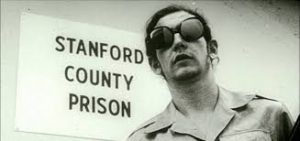1968 was a year of racial division and tragedy. African American’s had discussed the possibility of a boycott of the 1968 Summer Olympics. Dr. Martin Luther King Jr., a huge supporter of this boycott, said he would join Olympians John Carlos and Tommie Smith in Mexico to protest.1 These boycotts slowly fell through the cracks following the assassination of Martin Luther King Jr., and the riots during the Holy Week uprising. These riots were a direct response to the tragic death of MLK. Now that Dr. King would no longer be joining John Carlos in Mexico, other athletes became skeptical in boycotting the Summer Olympics. African American athletes began to change their stance on the boycott. The Olympians decided they would rather compete for themselves and their country, rather than sit out for a protest that would have a lot of attention in the media. But, John Carlos still felt like something needed to be done about the racially divided nation he lived in. With just a few weeks until the 1968 Summer Olympic Games, John Carlos had to decide how he would make his stand without the help or support of other Olympians or the civil rights activist Martin Luther King.2

With just ten days until the opening of the Summer Games, an unarmed group of student protesters gathered in Mexico City’s Three Cultures Square to plan their next step as a movement. The Mexican government sent bulldozers to break up the thousands of people who had gathered there. Mexican troops fired into the crowd, injuring and taking the lives of many people.3
This tragedy was eye-opening for both Carlos and Smith. Being in Mexico helped them to realize that they lived in a world that was unjust for all kinds of people. So the two decided that they needed to make a stand, and to be a voice for the voiceless.4 John Carlos and Tommie Smith knew that if they wanted to make a stand, it was imperative that they compete well enough to end up on the podium for the world to see.
Prior to their races, John Carlos and Tommie Smith decided that they both needed to make the podium together to make their stand through symbolism. The two men decided they would wear black gloves to symbolize strength and unity. They also wore beads around their necks to represent the history of lynching, and they decided to not wear shoes to symbolize black poverty in America.5 John Carlos and Tommie Smith wanted to do this because they felt that something needed to call attention to the broken and discriminated nature of their country. They wanted to make sure people were aware that there were those who lived in the “land of the free” that were far from free in terms of oppression.
The qualifying rounds had finally begun, and Tommie, unfortunately, pulled his groin in the quarter semi-finals. He refused to sit out though. Tommie was determined to compete because, to him, the race was so much bigger than he was, and bigger than anything else happening at the Olympics that summer.6
200m Final | Courtesy of Youtube
The finals had finally arrived. The next twenty seconds would be a defining moment for the two men. The gun sounded and the two flew. Tommie had a slow start but ended up setting a world record with a time of 19.57. John Carlos finished third, bested by Peter Norman by one step. But the two had made the podium, and it was time for them to make their stand. John Carlos told Norman what was about to happen, and Norman placed a button on him that read “We are Olympic Project for Human Rights,” to support the two men he was about to stand with on the podium.7

Carlos and Smith finally got their time on the podium, and as the two men’s fists shot up, 50,000 people fell silent. When the two walked toward the tunnel, following the National Anthem, people began booing and throwing things at them, screaming at them things like “Niggers need to go back to Africa,” and “I can’t believe this is how you Niggers treat us after we let you run in our games.”8 Then, in the midst of all this, the two stopped, threw their fists up again, screamed “right on,” and ran off the track.
The two got on the bus to begin the ride back to Olympic Village, and they got a glimpse of the rude awakening they were about to receive upon returning to the United States. As the two were about to sit down in the bus, a white man shouted: “those are the two that spit on my flag, you must be some kind of Communist.”9 The man continued badgering them until they arrived at Olympic Village.10
As the Olympics progressed, the USA Track team supported Carlos and Smith, and made signs to display throughout the remaining events. Following the United States winning the 4×100 relay finals, the team dedicated their win in an interview to Carlos and Smith. The US Olympic Committee was furious with the negative press that John Carlos and Tommie Smith were receiving for the scene they had caused, and the US Olympic Committee told the US team to either fly home or kick the two men off the team.11
Carlos and his wife were being bothered by the press constantly, and as they were heading to their hotel room one night, Carlos snapped and told the press: “Listen, I’m pretty pissed off with some of you white folk out there. The next one that takes a camera and microphone and sticks it up in my face, I am going to knock you down and act like you stole something.”12 These comments only escalated a situation that was already being blown up in the United States.13
After John Carlos and Tommie Smith returned home, they were suspended from the United States track team for making a scene on international television. And they began receiving death threats from many people.14 They were also being slammed in the media. Reporters called them “Blacked Skinned Storm Troopers,” while comparing their peaceful protest to a “Nazi Salute.”15 So much of the nation was infuriated with what these men had done. Some African Americans had even told them that they “set back black people 100 years.”16 The two refused to let the backlash quiet their message though, and they began speaking at colleges and in cities around the country to discuss equality in America. These men stood for something they believed in and got slandered in the media all over the world.17

Carlos and Smith felt like something needed to be done about the way people treated African Americans in America, and they refused to stand by and be complacent with the slow progress the United States had been making. It was not until 2008 that they received an ESPY award and were recognized in the media for their brave action.18 It’s truly tragic to see how these men were treated following the 1968 Summer Olympics, but it’s inspiring to see people fight and stand for what they believed in to call attention to issues they felt weren’t being adequately addressed in the United States. These men are part of the reason why we have made such great strides in the struggle for equality in America today.
- Erin Blakemore, “How the Black Power Protest at the 1968 Olympics Killed Careers,” History.com, February 22, 2018. Accessed February 14, 2019. https://www.history.com/news/1968-mexico-city-olympics-black-power-protest-backlash. ↵
- John Carlos, The John Carlos Story: The Sports Moment That Changed the World (Chicago, Illinois: Haymarket Books, 2011), 90-97. ↵
- Erin Blakemore, “How the Black Power Protest at the 1968 Olympics Killed Careers,” History.com, February 22, 2018. Accessed February 14, 2019. https://www.history.com/news/1968-mexico-city-olympics-black-power-protest-backlash. ↵
- Erin Blakemore, “How the Black Power Protest at the 1968 Olympics Killed Careers,” History.com, February 22, 2018. Accessed February 14, 2019. https://www.history.com/news/1968-mexico-city-olympics-black-power-protest-backlash. ↵
- John Carlos, The John Carlos Story: The Sports Moment That Changed the World (Chicago, Illinois: Haymarket Books, 2011), 110. ↵
- John Carlos, The John Carlos Story: The Sports Moment That Changed the World (Chicago, Illinois: Haymarket Books, 2011), 111-112. ↵
- John Carlos, The John Carlos Story: The Sports Moment That Changed the World (Chicago, Illinois: Haymarket Books, 2011), 112-113. ↵
- John Carlos, The John Carlos Story: The Sports Moment That Changed the World (Chicago, Illinois: Haymarket Books, 2011), 121. ↵
- John Carlos, The John Carlos Story: The Sports Moment That Changed the World (Chicago, Illinois: Haymarket Books, 2011), 123. ↵
- John Carlos, The John Carlos Story: The Sports Moment That Changed the World (Chicago, Illinois: Haymarket Books, 2011), 123. ↵
- Erin Blakemore, “How the Black Power Protest at the 1968 Olympics Killed Careers,” History.com, February 22, 2018. Accessed February 14, 2019. https://www.history.com/news/1968-mexico-city-olympics-black-power-protest-backlash. ↵
- John Carlos, The John Carlos Story: The Sports Moment That Changed the World (Chicago, Illinois: Haymarket Books, 2011), 124. ↵
- John Carlos, The John Carlos Story: The Sports Moment That Changed the World (Chicago, Illinois: Haymarket Books, 2011), 127. ↵
- John Carlos, The John Carlos Story: The Sports Moment That Changed the World (Chicago, Illinois: Haymarket Books, 2011), 130. ↵
- DeNeen L. Brown, “They didn’t #TakeTheKnee: The Black Power protest salute that shook the world in 1968,” The Washington Post, September 24, 2017. Accessed February 14, 2019. https://www.washingtonpost.com/news/retropolis/wp/2017/09/24/they-didnt-takeaknee-the-black-power-protest-salute-that-shook-the-world-in-1968/?utm_term=.97f6d2d0f51a. ↵
- “Sprinters are Both Suspended Because of Protest,” The Parsons Sun, Kansas, October 18, 1968. ↵
- DeNeen L. Brown, “They didn’t #TakeTheKnee: The Black Power protest salute that shook the world in 1968,” The Washington Post, September 24, 2017. Accessed February 14, 2019. https://www.washingtonpost.com/news/retropolis/wp/2017/09/24/they-didnt-takeaknee-the-black-power-protest-salute-that-shook-the-world-in-1968/?utm_term=.97f6d2d0f51a. ↵
- DeNeen L. Brown, “They didn’t #TakeTheKnee: The Black Power protest salute that shook the world in 1968,” The Washington Post, September 24, 2017. Accessed February 14, 2019. https://www.washingtonpost.com/news/retropolis/wp/2017/09/24/they-didnt-takeaknee-the-black-power-protest-salute-that-shook-the-world-in-1968/?utm_term=.97f6d2d0f51a. ↵



57 comments
Ruben Basaldu
Well written article and definitely worth the read. What these two men did is just amazing. They did what they felt passionate about on one of the biggest stages in front of millions of people because they wanted to spread their message. They didn’t use violence or any other tactic they just used themselves to show everyone what they stood for and for that they will remain in history forever.
Nathalie Figueroa Soto
What an inspirational story! Carlos and Smith realized that competing in the Olympics games meant something bigger than them, competing in a show of peaceful protest. It was disheartening to read about how they were harassed so severely for raising their fists at the podium, such as that man on the bus calling them Communists. Their impacts paved the way for less racial segregation in the United States, and their courage to stand up peacefully in the face of such disrespect is truly astounding. Great article!
Diamond Davidson
This article was really interesting to read, I never heard of this story before, so I’m glad I read it. This article hits the points of how people are being discriminated because of their differences. These young men started something decades ago but today we still see it. This is the importance of being courageous and stand up to the hate, this will make us equal and we need to start supporting one other in the things we do.
Mariah Cavanaugh
The courage of John Carlos and Tommie Smith is beyond admirable. Even in the face of racism and discrimination they stood their ground on their beliefs. These two men should have been commended, instead they were threatened, slandered and compared to Nazis. This draws parallels to the protest of Colin Kaepernick. The media was slamming Black Lives Matter protestors for their violent approach but when Kaepernick took part in his own peaceful protest he was vilified for it as well.
Diego Terrazas
This salute is quite symbolic and meaningful to black history. Such peaceful protests make huge impacts on society and certainly garners attention to racial issues. If these type of peaceful protests are showed on national TV, exposure to such issues is increased. Furthermore, these issues cannot be ignored or overlooked if it is shown in front of thousands of people.
Christopher Hohman
Nice article. It is good that these two athletes took a stand for racial equality at the 1968 Olympic Games. They did something quite similar to what we are witnessing in the NFL today. When players take a knee today they are peacefully fighting against racial injustice in the Police Force. Although the Black Power salute looks different than taking a knee.
Engelbert Madrid
The Olympics are one of the biggest sport events around the world, and for both John Carlos and Tommie Smith to do a peaceful protest against the United States’ racial segregation was one of the most outstanding moments in sport history. In my opinion, I could have not done that, because it takes a lot of courage to be able to do that. I enjoyed reading this article, and I’m glad I read it to understand the impact of peace protect in sport events.
Rebeca Escobar
Carlos and Smith’s actions on that day are still very controversial even today. I am very much for athletes protesting the injustices of their country, and I think people are so strict and bent on there being a line between social justice and a sport. Even athletes today face backlash for kneeling and refusing to stand for the flag because it is “disrespectful”, even though this kind of protest is a peaceful one. I feel like so many people just ignore why they decide to do these things and they don’t understand that discrimination and racial injustice still exists today.
Rosario Moreno
I had always seen the infamous picture of the men on the podium, but never knew the backstory and how much controversy behind the picture. I believe that what those two men did was not wrong in any way, they are expressing themselves peacefully for what they believe in. They knew well that they would have received criticism, but the criticism went farther than they would have imagined. I have gained much respect for them and what they stood for especially during this time being minorities. Great article!
Auroara-Juhl Nikkels
I had not really heard this story before reading your article. I think events like these are important and should be talked about more. You did a good job writing this article and I enjoyed reading and learning about this event. I am glad that in the end these two men were recognized for what they did. It takes a lot to do something when you know it could potentially end your career.